#rabindranath Tagore best story
Explore tagged Tumblr posts
Text
Today marks the 3rd anniversary of my fic The Infinity Cube. I can still remember posting the first chapter, hoping at least one person out there liked it, and I can still remember how it felt to reach the end, a feat that wouldn't have been possible without the support of so many kind souls 💗 I wanted to make something for the occasion and having seen so many amazing web weavings out there, I thought I'd give it my best shot 😊




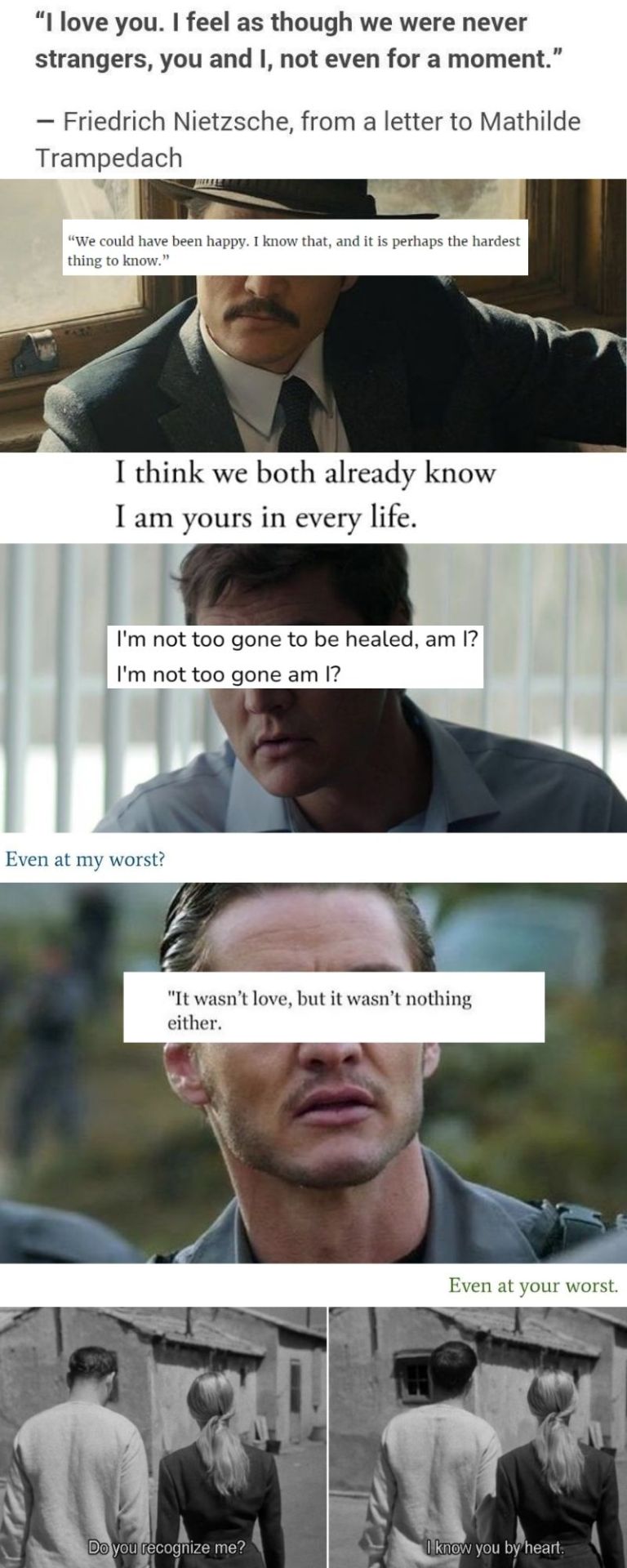

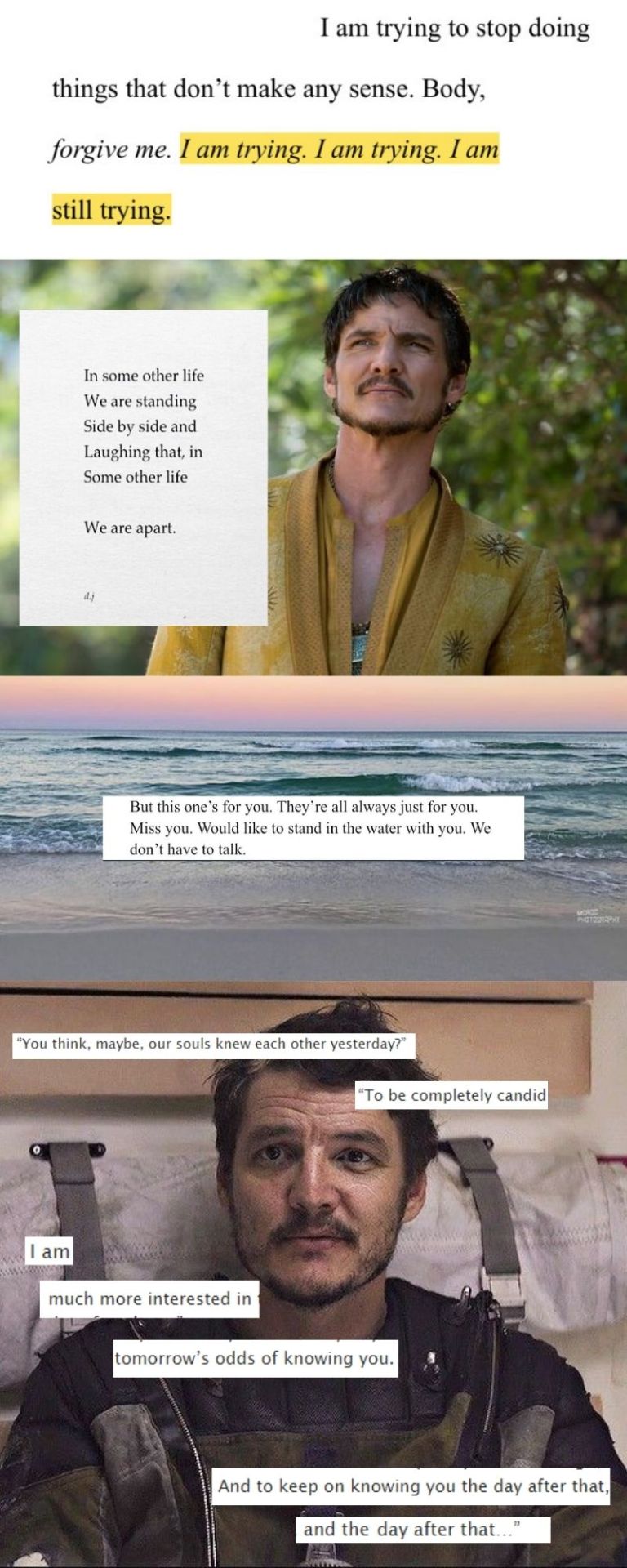
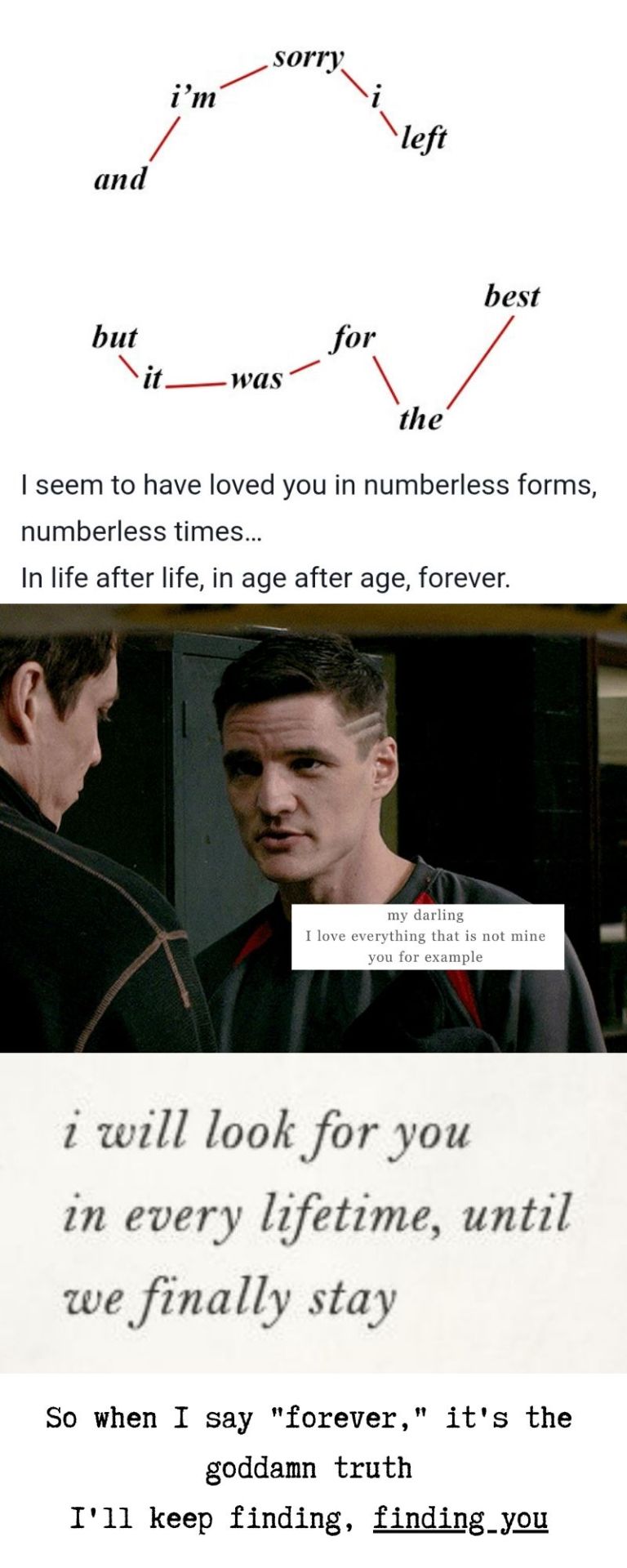
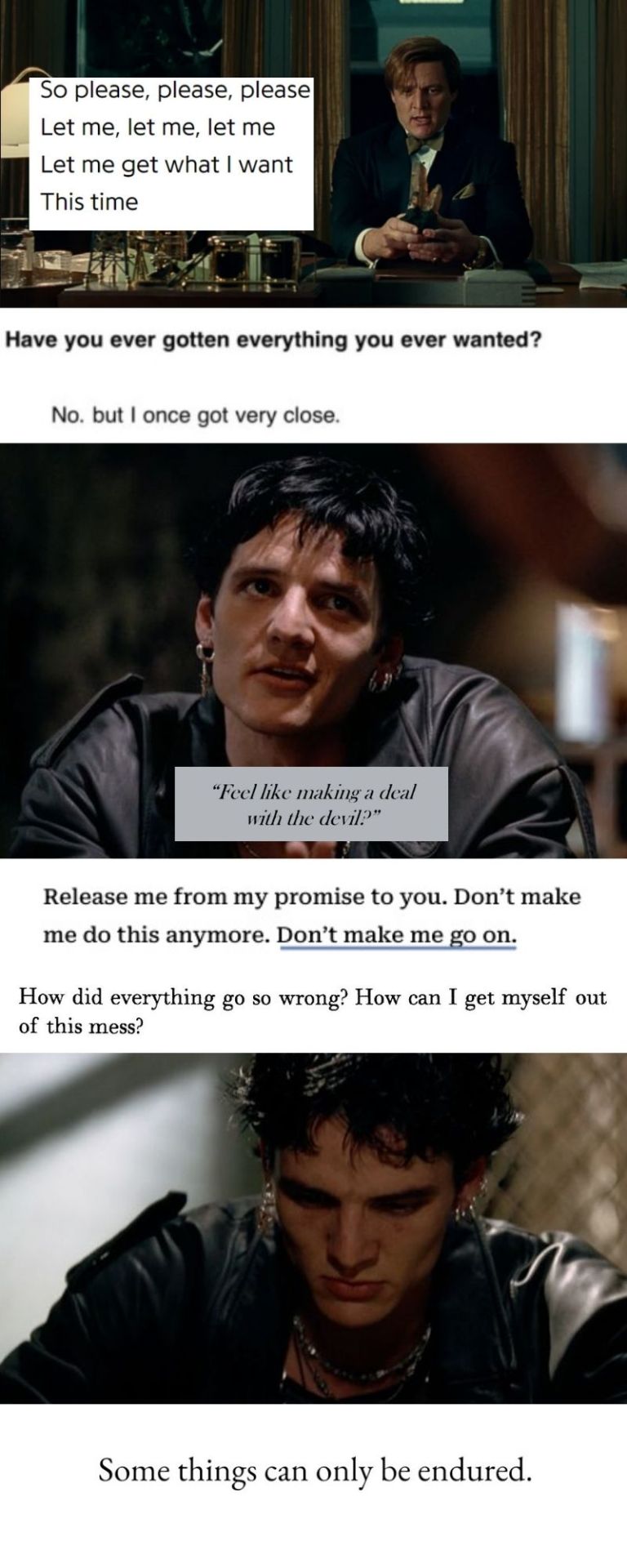


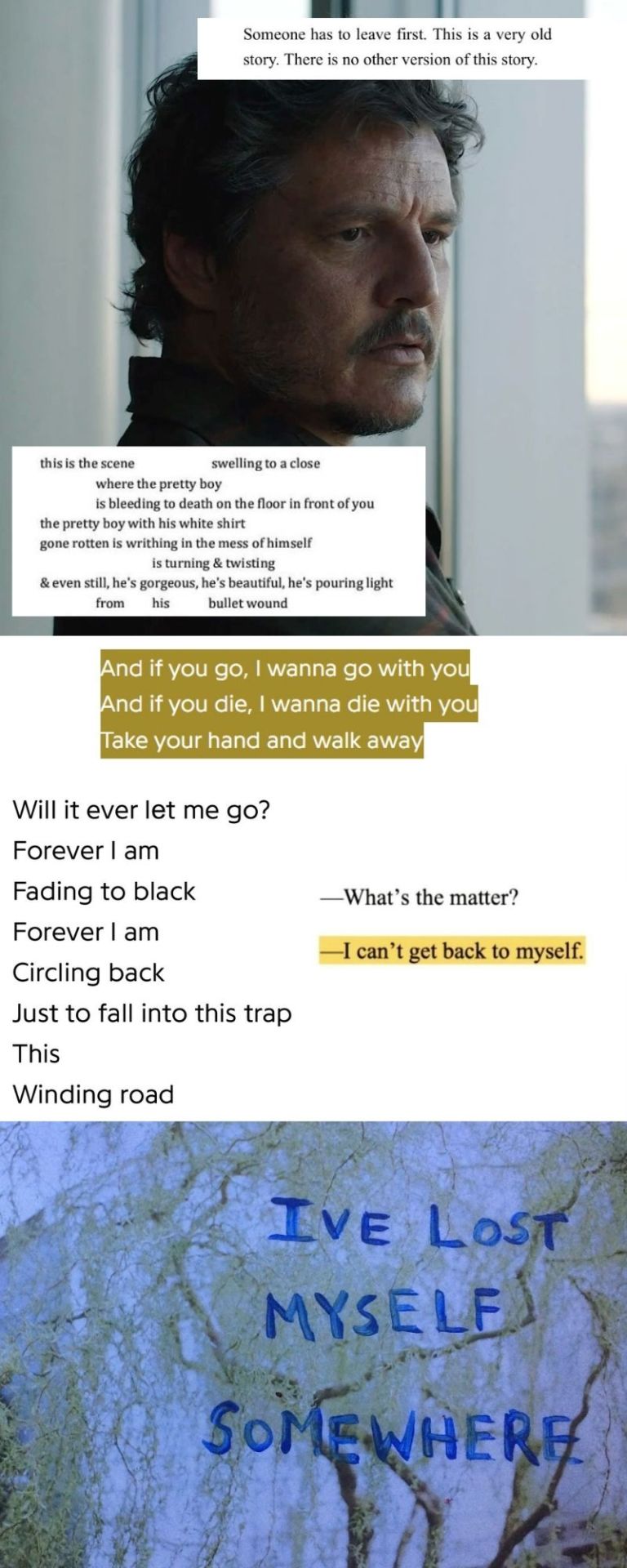



THE INFINITY CUBE: a journey home
Shades of Earth by Beth Revis // I Choose You by Adam Melchor // When Did It Happen? by Mary Oliver // First Love by Jennifer Franklin // The Picture of Dorian Gray by Oscar Wilde // The Bronze Horseman by Paullina Simons // The Amber Spyglass by Philip Pullman // 10 a.m Is When You Come To Me by Louise Bourgeois // Maybe In Another Universe, I Deserve You by Gaby Dunn // Maybe When the Time is Right You Will Find Me Again - K. Tolnoe // We Were Missing the Present by Mahmoud Darwish // Persona (1966) // Matched by Ally Condie // In the Pines by Alice Notley // It Wasn't Love // La Pointe Courte (1955) // "My better half" by Pablo J. Davis // The Song of Achilles by Madeline Miller // Bioshock Infinite // Calling a Wolf a Wolf by Kaveh Akbar // Oh It Was Meant to Be - Kate McGahan // Pillow Thoughts by Courtney Peppernell // If My Body Could Speak by Blythe Baird // Fourth of July by Sufjan Stevens // Unending Love by Rabindranath Tagore // The Blinding Star by Blanca Varela // Wild Spirit, Soft Heart by Butterflies Rising // Finding You by Kesha // Please, Please, Please Let Me Get What I Want by The Smiths // Web weaving about the untold story in you // "Feel like making a deal with the devil?" // A Little Life by Hanya Yanagihara // Reborn: Journals ad Notebooks by Susan Sontag // I love you like a rotten dog // Sax Rohmer #1 by The Mountain Goats // The Bubble (2022) // Rabbit Hole (2010) // Beginning with O by Olga Broumas // How many times can the same thing break your heart? // War of the Foxes by Richard Siken // On Death in Heartbreak // Lonely Day by System of A Down // This Road (The Mirror is a Trap) by Poe // Memory for Forgetfulness by Mahmoud Darwish // "Do you think we're soulmates in another universe?" // Radio Silence by Alice Oseman // "In one timeline we kiss" - Elizabeth Hewer // Tiny Beautiful Things: Advice on Love and Life from Dear Sugar by Cheryl Strayed // Almond Blossoms and Beyond by Mahmoud Darwish // X // The Collected Poems of Alvaro de Campos by Fernando Pessoa // Excerpt from Moony Moonless Sky's 'I am an observer, but not by choice' // @/lookoflove // Stone Butch Blues by Leslie Feinberg // "Do you know what it's like to live somewhere that loves you back?" - Danez Smith // Home by Edward Sharpe & The Magnetic Zeros // The Chaos of Stars by Kiersten White // Home // You and Me
All Pedro Photos - Pinterest // Reader in my story is physically a blank slate, I just really like the photo of Javi + Gabriela touching foreheads
82 notes
·
View notes
Note
what are your top five books? (love your writing by the way!!)
ANON THANK YOU!!! and thank you x2 for this question i was actually hoping id get asked this when i reblogged the post HAHEJEJEJWJEJEJ
im gonna paste the reviews i wrote for them (if i have them logged)
these are my top 5 books for 2024!
1. a thousand splendid suns - khaled hosseini (reread)
i think, above all, this is a love story in the broadest way possible. it is about love interwoven with fear, in an environment where survival is not guaranteed -- or, rather, is not guaranteed to be easy. in the context of the afghan war hosseini brings together two women under the same roof in a co-wifeship, and how, despite all the differences between them, love blossoms from their shared sisterhood and desire to protect one another. allyship against their abusive husband turns into a friendship turns into what becomes a mother-daughter relationship, a sharp, tearjerking contrast from the harsh conditional tolerance the rest of the world treat these women. a quote from the beginning of the book encapsulates this story perfectly: a man's heart is not like a mother's womb. it will not stretch to accommodate for you. it will not bleed. but despite not being of each other's wombs, mariam and laila did exactly this for one another, stretched and bled until, at least through one of them, they could experience a birth into a better life.
2. lolita - vladimir nabokov (reread)
lolita is not a love story. i have said this every time i have read the book, but in my third pass, as a 20 year old instead of a 14 or 17 year old, all the flowery prose, the carefully hidden details feel like they've been peeled off like a fruit skin and left the bare rinds of what this story is. humbert humbert kidnapped a 12 year old girl, drove her around the states, and raped her for a year. not to mention the abuse that continued after that.
this book deserves five stars because nabokov is clearly a master in creating an unreliable narrator. there were times i questioned whether anything we knew about humbert was real at all -- the small suggestions that he has embellished certain details, this insistence of creating 'art' and taking liberties for that purpose. you could argue that humbert is delusional, but i actually don't think he is. i think he knows exactly what he is and what he did but is psychopathically aware of creating a new version of himself and his story to make a good story for the 'jury'. because we do see his true colours, very often, in fact, colours that betray his claims that he loves lo, that he believes she's the one who can control him -- for example, the evaluation of Charlotte haze in his ability to 'twist her wrist' as he did with valeria, his almost disgust at some of the regular 12-year-old things lo was into (magazines, etc), and, most importantly, the fact he states the murder of quilty was actually the intended climax of his memoir all along, the whole purpose of his work. that's not to mention his obsession with 'capturing' lo -- in his journal entries, in the desire to take photos of her while she played tennis, in the very act of calling her 'lolita'.
i think this book is a disgusting, monstrous work of art. always enthralled by nabokov's mastery everytime i read this
3. rumi: selected poems
(this review was a load of nonsense so this is the redacted version)
like soap washing with our dirt, rumi cleans us, leaves us empty, draws our awareness back into the infinite.
4. gora - rabindranath tagore
after reading this i had to sit in silence for a while to just. process. because WOW. out of all of tagore's translated novels, this may have been my favourite -- the critical commentary on identity that home and the world could have been if it were longer! when binoy grows close to a brahmo family, conflict arises between him and his best friend gora -- a fierce adherant to hindu principles, especially the separation of caste. what follows are a series of events that brings into question the foundation of each character's religious principles -- what is impurity? what does it mean? how much of a person's worldly community should a person be expected to sacrifice for their religion? and how much of these principles are intrinsic, inherent in the hearts of all believers, and how much is learned, a garment clutched onto by believers for a sense of identity? to what extent can this garment be actually beneficial -- and to what extent harmful, weaponised to separate oneself from others and monochromise a world filled with different colours? filled with as many perspectives as there are characters, tagore observes the nature of religion, with all its guidance and restraints, and how spirituality can turn into tyranny in times where one's identity is threatened. a work extremely relevant to the british raj and the divisions thus created within hindustani society!
5. a little life - hanya yanagihara
i hestitated to pick this up because i've definitely heard some interesting opinions about it, to say the least. i've heard people say it's one of those books that are sad for no reason, that pile on the trauma just for the shock value. and, while on one hand, i can see where opinions like this come from, i can't disagree more. the sadness is there for a purpose. maybe not in a way that the characters can see, but in the way that we can see -- the purpose of showing us that no matter how much meaningless sadness, the unfairness of pain we have in our lives, the people who love us will always try to fight for us to stay alive, and, at the same time, how this fight may, at the end of the day, be for nothing, and yet it doesn't stop us from fighting. yanagihara explores friendship, love, and devotion, the decision to keep loving someone, the decision to make someone 'less sick' if they can't make them get better. heartbreaking in the futility of efforts, in the decades-lasting scars from experiences jude had no control over, in the complications in all his relationships, the people who want him to stay, and the trauma in him that makes it so hard to stay, we see that loving people isn't necessarily about how easy it is to be with them, but about how much we are willing to try.
ask me my top 5 anything
8 notes
·
View notes
Text
BEST DIRECTORS IN CINEMA-3
Hi everyone! This blog is going to be the 3rd part of 8 Part Series of who I think are the Best Directors Cinema as ever seen
And today I will be talking about
SATYAJIT RAY
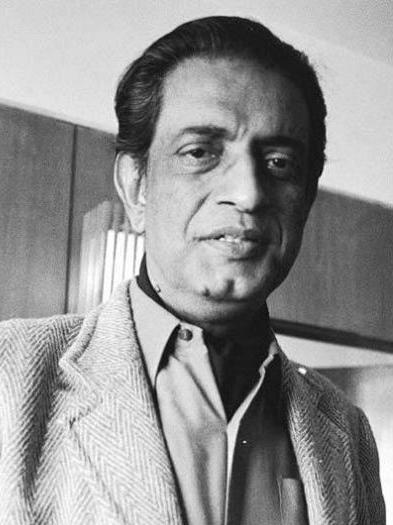
Satyajit Ray (born May 2, 1921, Calcutta [now Kolkata], India—died April 23, 1992, Calcutta) was a Bengali motion-picture director, writer, and illustrator who brought the Indian cinema to world recognition with Pather Panchali (1955; The Song of the Road) and its two sequels, known as the Apu Trilogy. As a director, Ray was noted for his humanism, his versatility, and his detailed control over his films and their music. He was one of the greatest filmmakers of the 20th century.
(Early Life)
Ray was an only child whose father died in 1923. His grandfather was a writer and illustrator, and his father, Sukumar Ray, was a writer and illustrator of Bengali nonsense verse. Ray grew up in Calcutta (now Kolkata) and was looked after by his mother. He entered a government school, where he was taught chiefly in Bengali, and then studied at Presidency College, Calcutta’s leading college, where he was taught in English. By the time he graduated in 1940, he was fluent in both languages. In 1940 his mother persuaded him to attend art school at Santiniketan, Rabindranath Tagore’s rural university northwest of Calcutta. There Ray, whose interests had been exclusively urban and Western-oriented, was exposed to Indian and other Eastern art and gained a deeper appreciation of both Eastern and Western culture, a harmonious combination that is evident in his films.
(His Famous Works)
Ray's first film, Pather Panchali (1955) won eleven international prizes, including the inaugural Best Human Document award at the 1956 Cannes Film Festival. This film, along with Aparajito (1956) and Apur Sansar (The World of Apu) (1959), form The Apu Trilogy. Ray did the scripting, casting, scoring, and editing, and designed his own credit titles and publicity material. He also authored several short stories and novels, primarily for young children and teenagers. Popular characters created by Ray include Feluda the sleuth, Professor Shonku the scientist, Tarini Khuro the storyteller, and Lalmohan Ganguly the novelist.
(Filmmaking Style)
His Filmmaking
Ray had been subconsciously paying a tribute to Jean Renoir throughout his career, who influenced him the most.Ray considered script-writing to be an integral part of direction. Initially he refused to make a film in any language other than Bengali. In his two non-Bengali feature films, he wrote the script in English; translators adapted it into Hindustani under Ray's supervision.The narrative structure of Ray's films are represented by musical forms such as sonata, fugue and rondo. Kanchenjunga, Nayak and Aranyer Din Ratri are examples of this structure.
(His Filmography)
Ray made over 36 feature film in his 4 decade long. He made movies such as Pather Panchali in 1955,Aparajito in 1956,Parash Pathar and Jalsaghar in 1958, Apur Sansar in 1959, Devi in 1960. He made movies such as Teen Kanya in 1961, Kanchenjungha and Abhijan in 1962,Mahanagar in 1963,Charulata and Two I'm 1964,Kapurush-0-Mahapurush in 1965,Nayak in 1966,Chiriyakhana in 1967,Goopy Gyne & Bagha Byne in 1969,Aranyer Din Ratri and Pratiwandi in 1970, Seemabaddha and Sikkim in 1971,Inner Eyes in 1972,Ashani Sanket in 1973,Sonar Kella in 1974,Jana Aranyw in 1975,Bala in 1976,Shatranj ka Khilari in 1977,Joi Baba Felunath in 1979,Hirak Rajar Deshe and Pikoo in 1980,Sadgati in 1981,Ghare Bhare in 1984,Sukumar Ray in 1987,Ganashatru and Shakha Proshakha in 1990,Agantuk in 1990.
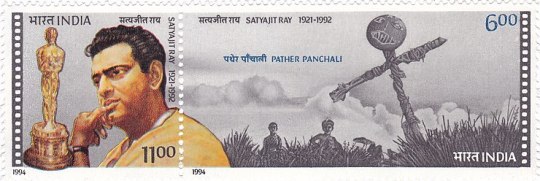
Satyajit Ray on 1994 stamp of India
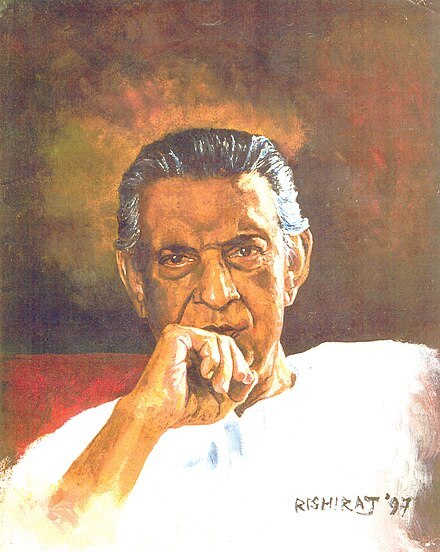
Portrait of Satyajit Ray
(Awards & Honors)
Ray received many awards including 36 National Film Awards. He was awarded the Dadasaheb Phalke Award in 1985 and Legion Of Honor in 1987. The Government of India also awarded him with Padma Bhusan in 1965. He also received a Lifetime Achievement Award in 1992 at the Academy of Motion Pictures Arts and Sciences. He also won the Golden Lion at the Venice Film Festival
(Legacy)
Ray is considered one of the greatest film directors of all time. He is a cultural icon in India and in Bengali communities worldwide. Following his death, the city of Calcutta came to a virtual standstill, as hundreds of thousands of people gathered around his house to pay their last respects. Ray's influence has been widespread and deep in Bengali cinema; many Bengali directors, including Aparna Sen, Rituparno Ghosh and Gautam Ghose as well as Vishal Bhardwaj, Dibakar Banerjee, Shyam Benegal and Sujoy Ghosh from Hindi cinema in India, Tareq Masud and Tanvir Mokammel in Bangladesh, and Aneel Ahmad in England, have been influenced by his craft.Beyond India, filmmakers Martin Scorsese, Francis Ford Coppola, George Lucas, James Ivory, Abbas Kiarostami, Elia Kazan, William Wyler,François Truffaut, John Huston, Carlos Saura, Isao Takahata, Oliver Stone,Quentin Tarantino, Wes Anderson,Danny Boyle and Christopher Nolan.
(Sources)
And that's it for this part folks, I'll meet you with another blog about some the Greatest Directors Cinema has ever seen, Until then
CIAO
3 notes
·
View notes
Photo

‘The Kneeling Man’ Review: The Story Behind the Photo
[‘The Kneeling Man’ Review: The Story Behind the Photo:: Marrell McCollough appeared on the balcony of the Lorraine Motel with King after an assassin’s bullet struck. How did he get there—and why?]
As the FBI declassifies documents, new informants continue to come to light. But Leta McCollough Seletzky didn’t need declassified reports to learn that her father, Marrell “Mac” McCollough, a Memphis police officer, had gone undercover with the Invaders, a black activist group, in the late 1960s; she discovered the truth by reading a newspaper article that happened to mention her father....What seems clear is that Mr. McCollough, who went from the U.S. Army to the Memphis Police Department to a career in the Central Intelligence Agency, shows few signs of feeling divided. He made his living in law enforcement and intelligence. If he harbored concern about whether his conduct betrayed the best interests of black Americans, he doesn’t confess them, not even to his daughter.
* * * *
On each race is laid the duty to keep alight its own lamp of mind as its part in the illumination of the world. To break the lamp of any people is to deprive it of its rightful place in the world festival. -Rabindranath Tagore, poet, philosopher, author, songwriter, painter, educator, composer, Nobel laureate
10 notes
·
View notes
Text
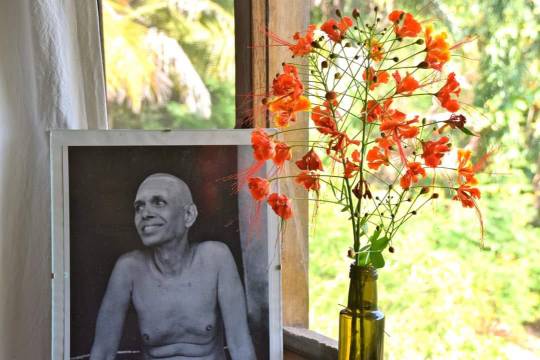
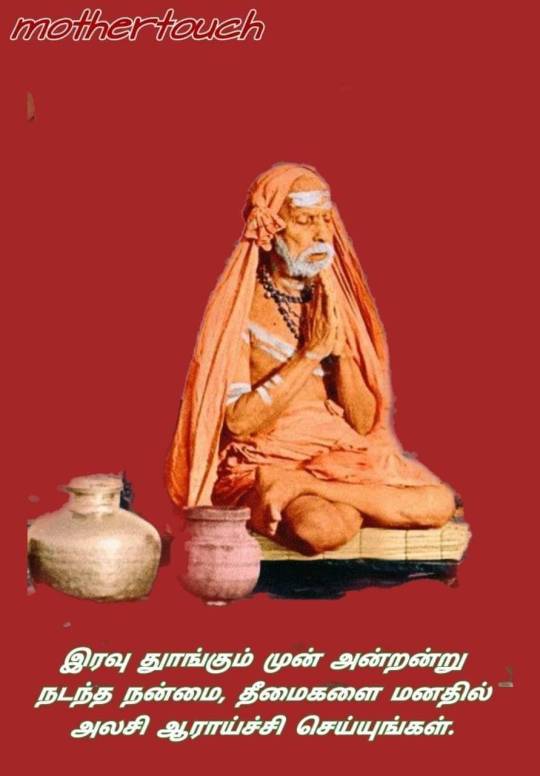
_*Experiences with Maha Periyava: Paul Brunton’s search for his Master*_
*Very Long but worth reading till the end.*
About the time of tiffin, that is, tea and biscuits, the servant announces a visitor. The latter proves to be a fellow member of the ink-stained fraternity, to wit, the writer Venkataramani. Several letters of introduction lie where I have thrown them, at the bottom of my trunk. I have no desire to use them. This is in response to a curious whim that it might be better to tempt whatever gods there be to do their best – or worst. However, I used one in Bombay, preparatory to beginning my quest, and I used another in Madras because I have been charged to deliver a personal message with it. And thus, this second note has brought Venkataramani to my door. He is a member of the Senate of Madras University, but he is better known as the author of talented essays and novels of village life. He is the first Hindu writer in Madras Presidency, who uses the medium of English, to be publicly presented with an inscribed ivory shield because of his services to literature.
He writes in a delicate style of such merit as to win high commendation from Rabindranath Tagore in India and from the late Lord Haldane in England. His prose is piled with beautiful metaphors, but his stories tell of the melancholy life of neglected villages.
As he enters the room I look at his tall, lean person, his small head with its tiny tuft of hair, his small chin and bespectacled eyes. They are the eyes of a thinker, an idealist and a poet combined. Yet the sorrows of suffering peasants are reflected in their sad irises. We soon find ourselves on several paths of common interest. After we have compared notes about most things, after we have contemptuously pulled politics to pieces and swung the censers of adoration before our favourite authors, I am suddenly impressed to reveal to him the real reason of my Indian visit. I tell him with perfect frankness what my object is; I ask him about the whereabouts of any real Yogis who possess demonstrable attainments; and I warn him that I am not especially interested in meeting dirt-besmeared ascetics or juggling faqueers.
He bows his head and then shakes it negatively. “India is no longer the land of such men. With the increasing materialism of our country, its wide degeneration on one hand and the impact of unspiritual Western culture on the other, the men you are seeking, the great masters, have all but disappeared. Yet I firmly believe that some exist in retirement, in lonely forests perhaps, but unless you devote a whole lifetime to the search, you will find them with the greatest difficulty. When my fellow Indians undertake such a quest as yours, they have to roam far and wide nowadays.
Then how much harder will it be for a European?”
“Then you hold out little hope?” I ask.
“Well, one cannot say. You may be fortunate.”
Something moves me to put a sudden question:
“Have you heard of a master who lives in the mountains of North Arcot?”
He shakes his head. Our talk wanders back to literary topics. I offer him a cigarette, but he excuses himself from smoking. I light one for myself and while I inhale the fragrant smoke of the Turkish weed, Venkataramani pours out his heart in passionate praise of the fast disappearing ideals of old Hindu culture. He makes reference to such ideas as simplicity of living, service of the community, leisurely existence and spiritual aims. He wants to lop off parasitic stupidities which grow on the body of Indian society. The biggest thing in his mind, however, is his vision of saving the half-million villages of India from becoming mere recruiting centres for the slums of large industrialized towns. Though this menace is more remote than real, his prophetic insight and memory of Western industrial history sees this as a certain result of present day
Trends. Venkataramani tells me that he was born in a family with a property near one of the oldest villages of South India, and he greatly lamented the cultural decay and material poverty into which village life had fallen. He loves to hatch out schemes for the betterment of the simple village folk, and he refuses to be happy whilst they are unhappy. I listen quietly in the attempt to understand his viewpoint. Finally, he rises to go and I watch his tall thin form disappear down the road.
Early next morning I am surprised to receive an unexpected visit from him. His carriage rushes hastily to the gate, for he fears that I might be out. “I received a message late last night that my greatest patron is staying for one day at Chingleput,” he bursts out. After he has recovered his breath, he continues: “His Holiness Shri Shankara Acharya of Kumbakonam is the Spiritual Head of South India. Millions of people revere him as one of God’s teachers. It happens that he has taken a great interest in me and has encouraged my literary career, and of course he is the one to whom I look for spiritual advice. I may now tell you what I refrained from mentioning yesterday. We regard him as a master of the highest spiritual attainment. But he is not a Yogi. He is the Primate of the Southern Hindu world, a true saint and great religious philosopher. Because he is fully aware of most of the spiritual currents of our time, and because of his own attainment, he has probably an exceptional knowledge of the real Yogis. He travels a good deal from village to village and from city to city, so that he is particularly well informed on such matters. Wherever he goes, the holy men come to him to pay their respects. He could probably give you some useful advice. Would you like to visit him?”
“That is extremely kind of you. I shall gladly go. How far is Chingleput?”
“Only thirty-five miles from here. But stay?”
”Yes?”
“I begin to doubt whether His Holiness would grant you an audience. Of course I shall do my utmost to persuade him.
But “”I am a European!” I finish the sentence for him. “I understand.”
” You will take the risk of a rebuff?” he asks, a little anxiously.
“Certainly. Let us go.”
After a light meal we set out for Chingleput. I ply my literary companion with questions about the man I hope to see this day. I learn that Shri Shankara lives a life of almost ascetic plainness as regards food and clothing, but the dignity of his high office requires him to move in regal panoply when travelling. He is followed then by a retinue of mounted elephants and camels, pundits and their pupils, heralds and camp followers generally. Wherever he goes he becomes the magnet for crowds of visitors from the surrounding localities. They come for spiritual, mental, physical and financial assistance. Thousands of rupees are daily laid at his feet by the rich, but because he has taken the vow of poverty, this income is applied to worthy purposes. He relieves the poor, assists education, repairs decaying temples and improves the condition of those artificial rain-fed pools which are so useful in the riverless tracts of South India. His mission, however, is primarily spiritual. At every stopping-place he endeavours to inspire the people to a deeper understanding of their heritage of Hinduism, as well as to elevate their hearts and minds. He usually gives a discourse at the local temple and then privately answers the multitude of querents who flock to him. I learn that Shri Shankara is the sixty-sixth bearer of the title in direct line of succession from the original Shankara. To get his office and power into the right perspective within my mind, I am forced to ask Venkataramani several questions about the founder of the line.
It appears that the first Shankara flourished over one thousand years ago, and that he was one of the greatest of the historical Brahmin sages. He might be described as a rational mystic, and as a philosopher of first rank. He found the Hinduism of his time in a disordered and decrepit state, with its spiritual vitality fast fading. It seems that he was born for a mission. From the age of eighteen he wandered throughout India on foot, arguing with the intelligentsia and the priests of every district through which he passed, teaching the doctrines of his own creation, and acquiring a considerable following. His intellect was so acute that, usually, he was more than a match for those he met. He was fortunate enough to be accepted and honoured as a prophet during his lifetime, and not after the life had flickered out of his throat. He was a man with many purposes. Although he championed the chief religion of his country, he strongly condemned the pernicious practices which had grown up under its cloak. He tried to bring people into the way of virtue and exposed the futility of mere reliance on ornate rituals, unaccompanied by personal effort. He broke the rules of caste by performing the obsequies at the death of his own mother, for which the priests excommunicated him. This fearless young man was a worthy successor to Buddha, the first famous caste breaker. In opposition to the priests he taught that every human being, irrespective of caste or colour, could attain to the grace of God and to knowledge of the highest Truth. He founded no special creed but held that every religion was a path to God, if sincerely held and followed into its mystic inwardness. He elaborated a complete and subtle system of philosophy in order to prove his points. He has left a large literary legacy, which is honoured in every city of sacred learning throughout the country. The pundits greatly treasure his philosophical and religious bequest, although they naturally quibble and quarrel over its meaning.
Shankara travelled throughout India wearing an ochre robe and carrying a pilgrim’s staff. As a clever piece of strategy, he established four great institutions at the four points of the compass. There was one at Badrinath in the North, at Puri in the East, and so on. The central headquarters, together with a temple and monastery, were established in the South, where he began his work. To this day the South has remained the holy of holies of Hinduism. From these institutions there would emerge, when the rainy seasons were over, trained bands of monks who travelled the country to carry Shankara’s message.
This remarkable man died at the early age of thirty-two, though one legend has it that he simply disappeared. The value of this information becomes apparent when I learn that his successor, whom I am to see this day, carries on the same work and the same teaching. In this connection, there exists a strange tradition. The first Shankara promised his disciples that he would still abide with them in spirit, and that he would accomplish this by the mysterious process of “overshadowing” his successors. A somewhat similar theory is attached to the office of the Grand Lama of Tibet. The predecessor in office, during his last dying moments, names the one worthy to follow him. The selected person is usually a lad of tender years, who is then taken in hand by the best teachers available and given a thorough training to fit him for his exalted post. His training is not only religious and intellectual, but also along the lines of higher Yoga and meditation practices. This training is then followed by a life of great activity in the service of his people. It is a singular fact that through all the many centuries this line has been established, not a single holder of the title has ever been known to have other than the highest and the most selfless character.
Venkataramani embellishes his narrative with stories of the remarkable gifts which Shri Shankara the Sixty-sixth possesses. There is an account of the miraculous healing of his own cousin. The latter has been crippled by rheumatism and confined to his bed for many years. Shri Shankara visits him, touches his body, and within three hours the invalid is so far better that he gets out of bed; soon, he is completely cured. There is the further assertion that His Holiness is credited with the power of reading the thoughts of other persons; at any rate, Venkataramani fully believes this to be true.
We enter Chingleput through a palm-fringed highway and find it a tangle of whitewashed houses, huddled red roofs and narrow lanes. We get down and walk into the centre of the city, where large crowds are gathered together. I am taken into a house where a group of secretaries are busily engaged handling the huge correspondence which follows His Holiness from his headquarters at Kumbakonam. I wait in a chairless anteroom while Venkataramani sends one of the secretaries with a message to Shri Shankara. More than half an hour passes before the man returns with the reply that the audience I seek cannot be granted. His Holiness does not see his way to receiving a European; moreover, there are two hundred people waiting for interviews already. Many persons have been staying in the town overnight in order to secure their interviews. The secretary is profuse in his apologies.
I philosophically accept the situation, but Venkataramani says that he will try to get into the presence of His Holiness as a privileged friend, and then plead my cause. Several members of the crowd murmur unpleasantly when they become aware of his intention to pass into the coveted house out of his turn. After much talk and babbling explanations, hewins through. He returns eventually, smiling and victorious.
“His Holiness will make a special exception in your case. He will see you in about one hour’s time.”
I fill the time with some idle wandering in the picturesque lanes which run down to the chief temple. I meet some servants who are leading a train of grey elephants and big buffbrown camels to a drinking-place. Someone points out to me the magnificent animal which carries the Spiritual Head of South India on his travels. He rides in regal fashion, borne aloft in an opulent howdah on the back of a tall elephant. It is finely covered with ornate trappings, rich cloths and gold embroideries. I watch the dignified old creature step forward along the street. Its trunk coils up and comes down again as it passes.
Remembering the time-worn custom which requires one to bring a little offering of fruits, flowers or sweetmeats whenvisiting a spiritual personage, I procure a gift to place before my august host. Oranges and flowers are the only things in sight and I collect as much as I can conveniently carry. In the crowd which presses outside His Holiness’s temporary residence, I forget another important custom. “Remove your shoes,” Venkataramani reminds me promptly. I take them off and leave them out in the street, hoping that they will still be there when I return!
We pass through a tiny doorway and enter a bare anteroom. At the far end there is a dimly lit enclosure, where I behold a short figure standing in the shadows. I approach closer to him, put down my little offering and bow low in salutation. There is an artistic value in this ceremony which greatly appeals to me, apart from its necessity as an expression of respect and as a harmless courtesy. I know well that Shri Shankara is no Pope, for there is no such thing in Hinduism, but he is teacher and inspirer of a religious flock of vast dimensions. The whole of South India bows to his tutelage.
I look at him in silence. This short man is clad in the ochrecoloured robe of a monk and leans his weight on a friar’s staff. I have been told that he is on the right side of forty, hence I am surprised to find his hair quite grey. His noble face, pictured in grey and brown, takes an honoured place in the long portrait gallery of my memory. That elusive element which the French aptly term spirituel is present in this face. His expression is modest and mild, the large dark eyes being extraordinarily tranquil and beautiful. The nose is short, straight and classically regular. There is a rugged little beard on his chin, and the gravity of his mouth is most noticeable. Such a face might have belonged to one of the saints who graced the Christian Church during the Middle Ages, except that this one possesses the added quality of intellectuality.
I suppose we of the practical West would say that he has the eyes of a dreamer. Somehow, I feel in an inexplicable way that there is something more than mere dreams behind those heavy lids.
“Your Holiness has been very kind to receive me,” I remark, by way of introduction. He turns to my companion, the writer, and says something in the vernacular. I guess its meaning correctly.
“His Holiness understands your English, but he is too afraid that you will not understand his own. So he prefers to have me translate his answers,” says Venkataramani.
I shall sweep through the earlier phases of this interview, because they are more concerned with myself than with this Hindu Primate. He asks about my personal experiences in the country; he is very interested in ascertaining the exact impressions which Indian people and institutions make upon a foreigner. I give him my candid impressions, mixing praise and criticism freely and frankly. The conversation then flows into wider channels and I am much surprised to find that he regularly reads English newspapers, and that he is well informed upon current affairs in the outside world. Indeed, he is not unaware of what the latest noise at Westminster is about, and he knows also through what painful travail the troublous infant of democracy is passing in Europe.
I remember Venkataramani’s firm belief that Shri Shankara possesses prophetic insight. It touches my fancy to press for some opinion about the world’s future.
“When do you think that the political and economic conditions everywhere will begin to improve?”
“A change for the better is not easy to come by quickly,” he replies. ” It is a process which must needs take some time. How can things improve when the nations spend more each year on the weapons of death?”
“There is nevertheless much talk of disarmament to-day. Does that count?”
“If you scrap your battleships and let your cannons rust that will not stop war. People will continue to fight, even if they have to use sticks!”
“But what can be done to help matters?”
“Nothing but spiritual understanding between one nation and another, and between rich and poor, will produce goodwill and thus bring real peace and prosperity.”
“That seems far off. Our outlook is hardly cheerful, then?”
His Holiness rests his arm a little more heavily upon his staff.
“There is still God,” he remarks gently.
” If there is, He seems very far away,” I boldly protest.
“God has nothing but love towards mankind,” comes the soft answer.
“Judging by the unhappiness and wretchedness which afflict the world to-day, He has nothing but indifference,”
I break out impulsively, unable to keep the bitter force of irony out of my voice. His Holiness looks at me strangely. Immediately I regret my hasty words.
“The eyes of a patient man see deeper. God will use human instruments to adjust matters at the appointed hour. The turmoil among nations, the moral wickedness among people and the suffering of miserable millions will provoke, as a reaction, some great divinely inspired man to come to the rescue. In this sense, every century has its own saviour. The process works like a law of physics. The greater the wretchedness caused by spiritual ignorance, materialism, the greater will be the man who will arise to help the world.”
“Then do you expect someone to arise in our time, too?”
” In our century,” he corrects. “Assuredly. The need of the world is so great and its spiritual darkness is so thick, that an inspired man of God will surely arise.”
“Is it your opinion, then, that men are becoming more degraded?” I query.
“No, I do not think so,” he replied tolerantly. “There is an indwelling divine soul in man which, in the end, must bring him back to God.”
“But there are ruffians in our Western cities who behave as though there were indwelling demons in them,” I counter, thinking of the modern gangster.
“Do not blame people so much as the environments into which they are born. Their surroundings and circumstances force them to become worse than they really are. That is true of both the East and West. Society must be brought into tune with a higher note. Materialism must be balanced by idealism; there is no other real cure for the world’s difficulties. The troubles into which countries are everywhere being plunged are really the agonies which will force this change, just as failure is frequently a sign-post pointing to another road.”
“You would like people to introduce spiritual principles into their worldly dealings, then?”
“Quite so. It is not impracticable, because it is the only way to bring about results which will satisfy everyone in the end, and which will not speedily disappear. And if there were more men who had found spiritual light in the world, it would spread more quickly. India, to its honour, supports and respects its spiritual men, though less so than in former times. If all the world were to do the same, and to take its guidance from men of spiritual vision, then all the world would soon find peace and grow prosperous.”
Our conversation trails on. I am quick to notice that Shri Shankara does not decry the West in order to exalt the East, as so many in his land do. He admits that each half of the globe possesses its own set of virtues and vices, and that in this way they are roughly equal! He hopes that a wiser generation will fuse the best points of Asiatic and European civilizations into a higher and balanced social scheme.
I drop the subject and ask permission for some personal questions. It is granted without difficulty.
“How long has Your Holiness held this title?”
“Since 1907. At that time I was only twelve years old. Four years after my appointment I retired to a village on the banks of the Cauvery, where I gave myself up to meditation and study for three years. Then only did my public work begin.”
“You rarely remain at your headquarters in Kumbakonam I take it?”
“The reason for that is that I was invited by the Maharajah of Nepal in 1918 to be his guest for a while. I accepted and since then have been travelling slowly towards his state in the far north. But see! – during all those years I have not been able to advance more than a few hundred miles, because the tradition of my office requires that I stay in every village and town which I pass on the route or which invites me, if it is not too far off. I must give a spiritual discourse in the local temple and some teaching to the inhabitants.”
I broach the matter of my quest and His Holiness questions me about the different Yogis or holy men I have so far met. After that, I frankly tell him: “I would like to meet someone who has high attainments in Yoga and can give some sort of proof or demonstration of them. There are many of your holy men who can only give one more talk when they are asked for this proof. Am I asking too much?”
The tranquil eyes meet mine. There is a pause for a whole minute. His Holiness fingers his beard.
” If you are seeking initiation into real Yoga of the higher kind, then you are not seeking too much. Your earnestness will help you, while I can perceive the strength of your determination; but a light is beginning to awaken within you which will guide you to what you want, without doubt.”
I am not sure whether I correctly understand him. “So far I have depended on myself for guidance. Even some of your ancient sages say that there is no other god than that which is within ourselves,” I hazard.
And the answer swiftly comes: “God is everywhere. How can one limit Him to one’s own self? He supports the entire universe.”
I feel that I am getting out of my depth and immediately turn the talk away from this semi-theological strain.
“What is the most practical course for me to take?”
“Go on with your travels. When you have finished them, think of the various Yogis and holy men you have met; then pick out the one who makes most appeal to you. Return to him, and he will surely bestow his initiation upon you.”
I look at his calm profile and admire its singular serenity.
“But suppose, Your Holiness, that none of them makes sufficient appeal to me. What then? ”
“In that case you will have to go on alone until God Himself initiates you. Practise meditation regularly; contemplate the higher things with love in your heart; think often of the soul and that will help to bring you to it. The best time to practise is the hour of waking; the next best time is the hour of twilight. The world is calmer at those times and will disturb your meditations less.”
He gazes benevolently at me. I begin to envy the saintly peace which dwells on his bearded face. Surely, his heart has never known the devastating upheavals which have scarred mine? I am stirred to ask him impulsively:
”If I fail, may I then turn to you for assistance?”
Shri Shankara gently shakes his head. “I am at the head of a public institution, a man whose time no longer belongs to himself. My activities demand almost all my time. For years I have spent only three hours in sleep each night. How can I take personal pupils? You must find a master who devotes his time to them.”
“But I am told that real masters are rare, and that a European is unlikely to find them.”
He nods his assent to my statement, but adds:
“Truth exists. It can be found.”
“Can you not direct me to such a master, one who you know is competent to give me proofs of the reality of higher Yoga?”
His Holiness does not reply till after an interval of protracted silence.
“Yes. I know of only two masters in India who could give you what you wish. One of them lives in Benares, hidden away in a large house, which is itself hidden among spacious grounds. Few people are permitted to obtain access to him; certainly, no European has yet been able to intrude upon his seclusion. I could send you to him, but I fear that he may refuse to admit a European.”
“And the other?” My interest is strangely stirred.
“The other man lives in the interior, farther south. I visited him once and know him to be a high master. I recommend that you go to him.”
“Who is he?”
“He is called the Maharishee. I have not met him, but know him to be a high master. Shall I provide you with full instructions, so that you may discover him?”
A picture flashes suddenly before my mind’s eye. I see the yellow-robed friar, who has vainly persuaded me to accompany him to his teacher. I hear him murmuring the name of a hill. It is: “The Hill of the Holy Beacon.”
“Many thanks, Your Holiness,” I rejoin, “but I have a guide who comes from the place.”
“Then you will go there?”
I hesitate.
“All arrangements have been made for my departure from the South to-morrow,” I mutter uncertainly.
” I n that case I have a request to make.”
“With pleasure.”
“Promise me that you will not leave South India before you have met the Maharishee.”
I read in his eyes a sincere desire to help me. The promise is given.
A benignant smile crosses his face.
“Do not be anxious. You shall discover that which you seek.”
A murmur from the crowd which is in the street penetrates the house.
“I have taken up too much of your valuable time,” I apologize. ” I am indeed sorry.”
Shri Shankara’s grave mouth relaxes. He follows me into the ante-room and whispers something into the ear of my companion. I catch my name in the sentence. At the door I turn to bow in farewell salutation. His Holiness calls me back to receive a parting message: “You shall always remember me, and I shall always remember you!”
And so, hearing these cryptic and puzzling words, I reluctantly withdraw from this interesting man, whose entire life has been dedicated to God from childhood. He is a pontiff who cares not for worldly power, because he has renounced all and resigned all. Whatever material things are given to him, he at once gives again to those who need them. His beautiful and gentle personality will surely linger in my memory.
I wander about Chingleput till evening, exploring its artistic, old-world beauty, and then seek a final glimpse of His Holiness before returning home. I find him in the largest temple of the city. The slim, modest, yellow-robed figure is addressing a huge concourse of men, women and children. Utter silence prevails among the large audience. I cannot understand his vernacular words, but I can understand that he is holding the deep attention of all present, from the intellectual Brahmin to the illiterate peasant. I do not know, but I hazard the guess that he speaks on the profoundest topics in the simplest manner, for such is the character I read in him.
And yet, though I appreciate his beautiful soul, I envy the simple faith of his vast audience. Life, apparently, never brings them deep moods of doubt. God is; and there the matter ends. They do not appear to know what it means to go through dark nights of the soul, when the world seems like the grim scene of a jungle-like struggle; when God recedes into shadowy nothingness; and when man’s own existence seems nothing more than a fitful passage across this small, transient fragment of the universe which we call Earth. We drive out of Chingleput under an indigo sky gemmed with stars. I listen to palms majestically waving their branches over the water’s edge in an unexpected breeze.
My companion suddenly breaks the silence between us.
“You are indeed lucky!”
“Why?”
“Because this is the first interview which His Holiness has granted to a European writer.”
“Well?”
“That brings his blessing upon you!”
It is nearly midnight when I return home. I take a last glimpse overhead. The stars stud the vast dome of the sky in countless myriads. Nowhere in Europe can one see them in such overwhelming numbers. I run up the steps leading to the veranda, flashing my pocket torch. Out of the darkness, a crouching figure rises and greets me.
“Subramanya!” I exclaim, startled. “What are you doing here?” The ochre-robed Yogi indulges in one of his tremendous grins.
“Did I not promise to visit you, Sir?” He reminds me reproachfully.
“Of course!”
In the large room, I fire a question at him. “Your master – is he called the Maharishee?”
It is now his turn to draw back, astonished.
“How do you know, sir? Where could you have learnt this?”
“Never mind. To-morrow we both start for his place.
“This is joyful news, sir.”
“But I shall not stay there long, though. A few days, maybe.”
I fling a few more questions at him during the next half-hour, and then, thoroughly tired, go to bed. Subramanya is quite content to sleep on a piece of palm matting which lies on the floor. He wraps himself up in a thin cotton cloth, which serves at once as a mattress, sheet and blanket, and disdains my offer of more comfortable bedding.
The next thing of which I am aware is suddenly awakening. The room is totally dark. I feel my nerves strangely tense.The atmosphere around me seems like electrified air. I pull my watch from under the pillow and, by the glow of its radium-lit dial, discover the time to be a quarter to three. It is then that I become conscious of some bright object at the foot of the bed. I immediately sit up and look straight at it. My astounded gaze meets the face and form of His Holiness Shri Shankara. It is clearly and unmistakably visible. He does not appear to be some ethereal ghost, but rather a solid human being. There is a mysterious luminosity around the figure which separates it from the surrounding darkness. Surely the vision is an impossible one? Have I not left him at Chingleput? I close my eyes tightly in an effort to test the matter. There is no difference and I still see him quite plainly! Let it suffice that I receive the sense of a benign and friendly presence. I open my eyes and regard the kindly figure in the loose yellow robe.
The face alters, for the lips smile and seem to say: “Be humble and then you shall find what you seek!”
Why do I feel that a living human being is thus addressing me? Why do I not regard it as a ghost, at least?
The vision disappears as mysteriously as it has come. It leaves me feeling exalted, happy and unperturbed by its supernormal nature. Shall I dismiss it as a dream? What matters it?
There is no more sleep for me this night. I lie awake pondering over the day’s meeting, over the memorable interview with His Holiness Shri Shankara of Kumbakonam, the Hierarch of God to the simple people of South India.
3 notes
·
View notes
Text
Dear @galexy-astra, thank you so much for tagging me! HUGS <333333
I am absolutely using this to talk about my current Book Slut Behaviour (TM) so thank you for giving me an opening for that. Putting a read more to keep yalls dashes clean and hygienic. <3
Tag Game To Better Know You! Send this to people you'd like to know better!
Book I'm Currently Reading: I am currently going WILD with reading, and I'm on my mission to read my way a) through the 100 Best Books according to TIMES list and check out the Nobel prize for Lit winners, b) "around the world" (one book per country), and c) read classics I've always wanted to read but have never gotten around to. This is an open-ended mission though and I'm not doing it all in one year or some such insanity.
Bygone Days: O'tkan Kunlar by Abdullah Qodiriy. An Uzbek author telling a love story and the various obstacles the main characters have to deal with, giving a fantastic account of Uzbek culture in the 19th century.
Great Expectations by Charles Dickens (through Dickens Daily). Guys I'm sorry I hate Charles Dickens and reading it in small bits and pieces is the only way I'll ever finish one of his books. rip
Frankenstein by Mary Shelly (through Frankstein Weekly). It just started yesterday!!! Sign upppp for some Gothic Goodness!!
Next books to read are Typee by Herman Melville (I loved Moby Dick so much I need more Melville in my life) and The Home and the World by Rabindranath Tagore (Nobel prize and pretty cover, I am too easy).
What I usually wear: Skinny jeans, Nike sneakers, and a crop top or jumper (weather permitting). At work, cigarette trousers, a simple shirt, and a blazer or nice coat.
How tall I am: 170 cm (5 foot 7)
My star sign. Do I know any celebrities or historical event that shares it: Aquarius. Yes I know of some but they're all unfavourable so I ignore them!
Do I go by a name or nickname: Sam is my nickname, Samantha is my full name :)
Did I grow up to be what I wanted to be as a child: Oh dear. Absolutely not, archaeology and heritage were always just a 'obviously I'm interested' but never a passion before I ended up with it by complete coincidence... but I don't think my child-self would be disappointed. She would shrug it off that I changed disciplines like two hundred times lol.
Something I'm good at vs Something I'm bad at: I am good with Excel and I am bad at ball sports!
If I draw or write, what's my favourite of anything I created this year?: I have not yet written anything this year, at all, outside of work... :(
Dogs or cats: Cats!
Something I would like to make content for: I would like to get back into writing, no matter what for! Original, my old ships, Moby Dick, something new that I enjoyed like interview with the vampire,,, someone enable me
Something I was excited about that turned out to disappoint me: Living in Paris LMAOOO this is very cliche and I'm not even disappointed by the city itself, but dear god the people are so incredibly rude! It's frankly disheartening
Hidden talent: I write song texts for my dad's (hobby) hard rock band and they recently studio recorded a song I wrote!!!
Something I wish to have at this very moment: The confirmation email for my phd funding... :( i will not know about it for another couple of months tho
Tagging (no pressure!!!): @game-set-canet @backwardsandinhighheels @blorbocedes @historygeek12 @gp2engine and everyone else who comes across this and would like to do it! <3
3 notes
·
View notes
Text
The Taj Mahal: India’s Favorite Heritage Monument in 2024

Famed poet Rabindranath Tagore called it "a teardrop on the cheek of the universe," while Rudyard Kipling described it as "the embodiment of all things pure." The Mughal emperor Shah Jahan declared it a creation so profound that "it made the moon and the sun drop tears on it." Yes, we are speaking of the Taj Mahal, the iconic symbol of eternal love and architectural splendor.
This breathtaking marvel in Agra has drawn millions of admirers from across the world. With its rich Mughal history and mesmerizing architecture, the Taj Mahal stands as a tribute to love, inspiring awe and reverence. And if you haven’t yet seen this jewel under the moonlit sky, prepare for one of the most enchanting sights of your lifetime.
For those planning a trip, many India holiday packages include a visit to the Taj Mahal, making it easier to explore this magnificent landmark without the hassle of planning every detail.
About the Taj Mahal
Nestled in the historic city of Agra, the Taj Mahal is often hailed as the most beautiful building in the world. This UNESCO World Heritage Site is celebrated as the "symbol of love" for its heartwarming story and intricate artistry.
Known as the Crown of Palaces in Persian, the Taj’s ethereal beauty is amplified by its symmetric gardens, intricate marble designs, and geometric patterns. The delicate pietra dura (marble inlay work) showcases thousands of semiprecious stones, creating a masterpiece of craftsmanship. This unparalleled work of Mughal architecture continues to captivate visitors with its elegance, symmetry, and romantic legacy.
Best Time to Visit
For the most breathtaking views, visit the Taj Mahal during sunrise or sunset. The soft hues of the sky beautifully complement the shimmering white marble, offering a picture-perfect moment.
The best months to explore Agra and the Taj Mahal are from October to March, when the weather is pleasant and ideal for sightseeing. Many India holiday packages from Dubai also recommend this season to travelers, ensuring an enjoyable and comfortable journey.
A Brief History of the Taj Mahal
The story of the Taj Mahal is one of love and loss. It was commissioned in 1632 by Emperor Shah Jahan in memory of his beloved wife, Mumtaz Mahal, who died giving birth to their 14th child. Heartbroken, Shah Jahan poured his grief into creating a memorial unlike any other.
The construction of this grand mausoleum took 22 years and involved over 20,000 artisans from India and Central Asia. European specialists were brought in to perfect the intricate marble work, while materials like white marble and semiprecious stones were sourced from distant lands.
Although the Taj Mahal was completed in 1653, Shah Jahan's joy was short-lived. Overthrown by his son Aurangzeb, he spent his remaining years imprisoned in the Agra Fort, where he gazed upon the Taj Mahal from a distance. He was laid to rest beside Mumtaz Mahal in this timeless monument of love in 1666.
In 1983, the Taj Mahal earned its place as a UNESCO World Heritage Site and underwent major restoration during the early 20th century. Today, it remains a global symbol of beauty and devotion, drawing millions to Agra every year.
FAQs About the Taj Mahal
Q: Why was the Taj Mahal built?A: The Taj Mahal was built by Emperor Shah Jahan in memory of his wife Mumtaz Mahal as a testament to their eternal love.
Q: How many Taj Mahals are there?A: While there is only one Taj Mahal, there exists a replica called Bibi Ka Maqbara in Aurangabad, Maharashtra. Built by Shah Jahan’s grandson, Prince Aazam Shah, in memory of his mother Dilras Banu Begum, it is often referred to as the Taj of the Deccan.
Why Visit the Taj Mahal in 2024?
In 2024, the Taj Mahal continues to be a top travel destination for its timeless appeal and historical significance. Whether you're drawn to its love story, intricate design, or cultural value, the Taj offers an experience unlike any other.
Take a step back in time, marvel at the Mughal-era grandeur, and immerse yourself in the romance and beauty of this world wonder. Make 2024 the year you witness this incredible heritage site firsthand.
#holidays#tourism#tours#travel#travel management company#visa services#corporate travel management#vacation#trip#india#monument#taj mahal
0 notes
Text
28 Best Locations for a Pre-Wedding Photoshoot in Kolkata
Are you dreaming of a pre-wedding photoshoot that captures the essence of Kolkata’s charm and timeless beauty? Look no further! Kolkata, often called the City of Joy, offers a perfect blend of heritage, natural beauty, and urban landscapes. Whether you're looking for royal backdrops or intimate, picturesque settings, this city has a plethora of locations to make your pre-wedding photoshoot memorable.
In this blog, we’ll explore the top 28 pre-wedding photoshoot locations in Kolkata that will capture the essence of your love story against this vibrant city's beautiful and historic backdrop.
Why Kolkata is the Perfect Place for a Pre-Wedding Shoot
Kolkata is a city that seamlessly blends the old with the new. From colonial architecture to modern marvels, from lush gardens to serene riversides, it offers a variety of settings that cater to every aesthetic. Each location tells its own story, which is why couples choose this for their pre-wedding photography in kolkata. It’s not just about the photos; it’s about the experience of immortalizing your love in the heart of a city that is steeped in culture and history.
So, if you're on the lookout for a location that will bring out the romance and magic in your photos, here's a roundup of the 28 best pre-wedding photoshoot locations in Kolkata.
1. Victoria Memorial
One of Kolkata’s most iconic landmarks, Victoria Memorial is the epitome of elegance. Its white marble facade, sprawling gardens, and majestic architecture create a grand backdrop for your pre-wedding shoot.
2. Howrah Bridge
The Howrah Bridge is synonymous with Kolkata’s identity. Whether you capture the bridge from afar or pose in front of it, the structure's grandeur adds a distinctive urban flair to your photos.
3. Princep Ghat
By the Hooghly River, Princep Ghat is famous for its colonial architecture and serene riverside view. The mix of greenery and heritage structures makes it an ideal place for romantic and timeless shots.
4. Kumartuli
For a cultural twist, Kumartuli is perfect. Known for its artisans crafting Durga idols, this place offers a blend of rustic charm and artistic flair, perfect for couples who want to add a traditional element to their photoshoot.
5. Indian Museum
If you're looking for a touch of grandeur and history, the Indian Museum provides a rich backdrop with its colonial architecture and artifact-filled interiors.
6. Rabindra Sarobar
Rabindra Sarobar offers a peaceful lakeside setting. The lush greenery, walking trails, and calm waters create a tranquil environment, ideal for intimate photos.
7. Marble Palace
A hidden gem, the Marble Palace is a stunning location with its vintage European architecture, manicured gardens, and stately ambiance. It offers a royal feel that will make your photos regal and elegant.
8. St. Paul’s Cathedral
This Anglican cathedral is known for its Gothic architecture and towering spires. The serene atmosphere and impressive structure offer a spiritual yet aesthetic setting for your pre-wedding shoot.
9. Eco Park
For nature lovers, Eco Park is a sprawling location with multiple themed zones. Whether you want a lake, a butterfly garden, or wide-open green spaces, this park offers a variety of settings to choose from.
10. Jorasanko Thakur Bari
The ancestral home of Rabindranath Tagore, Jorasanko Thakur Bari, is a place of deep cultural significance. Its historical vibe and beautiful red-brick architecture offer a unique, romantic backdrop.
11. College Street
For a quirky, intellectual vibe, College Street offers endless photo opportunities. The bustling street filled with bookshops and the iconic Indian Coffee House will add a literary touch to your shoot.
12. Maidan
Maidan, Kolkata’s largest urban park, offers endless greenery and a stunning view of the cityscape. With open spaces and the city in the background, it’s perfect for candid and fun-loving shots.
13. Indian Coffee House
Want to capture your love over a cup of coffee? The iconic Indian Coffee House is perfect for candid, relaxed moments filled with nostalgia and charm.
14. South Park Street Cemetery
For a gothic and historical vibe, South Park Street Cemetery offers a hauntingly beautiful location with its colonial tombstones, old trees, and serene atmosphere.
15. Biswa Bangla Gate
A modern landmark, Biswa Bangla Gate offers a panoramic view of New Town. It’s a perfect spot for couples looking for an ultra-modern and unique backdrop for their pre-wedding photoshoot.
16. College Square
Famous for its beautiful water body and the surrounding colonial-era buildings, College Square is a perfect location if you're looking to blend history with a serene lakeside setting.
17. Shobhabazar Rajbari
For a royal pre-wedding shoot, Shobhabazar Rajbari provides a majestic backdrop. This historic mansion exudes old-world charm and offers a glimpse into Bengal’s rich heritage.
18. Elliot Park
If you're looking for a quiet spot in the middle of the city, Elliot Park offers a beautiful green space with walking paths and cozy corners for romantic shots.
19. Millennium Park
This riverside park offers a beautiful blend of natural beauty and urban aesthetics. The Hooghly River, combined with the scenic park, creates a dreamy setting for your pre-wedding pictures.
20. Itachuna Rajbari
Located on the outskirts of Kolkata, Itachuna Rajbari offers a stunning, regal setting for your photoshoot. The old palace, complete with courtyards and gardens, provides a vintage, royal vibe.
21. Mallick Ghat Flower Market
The bustling flower market near Howrah Bridge is a vibrant and colorful location for photos. The freshness of the flowers and the liveliness of the market add a burst of energy to your shoot.
22. Bow Barracks
Bow Barracks offers a slice of Kolkata’s Anglo-Indian heritage. The red-bricked buildings and narrow alleys create a quaint and vintage atmosphere, perfect for couples who want something unique.
23. Smaranika Tram Museum
For a quirky and vintage feel, the Smaranika Tram Museum, located inside a real tram, is a fun and offbeat location. This one-of-a-kind setting will give your photos an unconventional charm.
24. Botanical Garden
Nature enthusiasts will love the wide variety of plants and scenic beauty at the Botanical Garden. The giant banyan tree, lush greenery, and peaceful environment make it a great choice for nature-inspired shots.
25. Nicco Park
For couples looking for a fun-filled, vibrant photoshoot, Nicco Park offers an amusement park setting that’s full of energy and excitement. Capture playful, joyful moments here.
26. Chintamoni Kar Bird Sanctuary
This bird sanctuary is perfect for nature lovers. The dense forest, chirping birds, and peaceful environment offer a secluded, natural setting for a serene and intimate photoshoot.
27. Calcutta Bungalow
For a vintage, colonial vibe, Calcutta Bungalow offers a beautifully restored heritage home. The antique decor and historical charm make it an extraordinary location for capturing elegant moments.
28. Bortir Bil
For couples who want a nature-centric shoot, Bortir Bil, located on the city’s outskirts, offers serene water bodies, fields, and open skies, providing a tranquil and picturesque backdrop.
Conclusion
Kolkata is a city that offers a multitude of options for pre-wedding shoots, whether you want a traditional, historical, modern, or nature-inspired backdrop. Each location has its own charm, and the city’s diversity ensures that every couple can find the perfect spot that resonates with their love story. So, get ready to pose, laugh, and make memories as you explore these stunning pre-wedding photoshoot locations in Kolkata!
Let the City of Joy be the canvas where your love is painted, one click at a time! Read this blog and Discover The Best Paid Pre Wedding Photoshoot Location In Kolkata
0 notes
Text
Exclusively Watch The Best Indian Series Online For Crime And Mystery Lovers.
Introduction:-
Regarding captivating crime thrillers, Indian cinema has produced some of the most compelling series that keep viewers hooked from start to finish. If you enjoy watching Indian series online, you’re in for a treat. Epic On, a premier streaming platform, offers an impressive collection of crime thrillers that delve deep into intriguing narratives, complex characters, and gripping plots. If you're a fan of historical crime dramas, psychological thrillers, or modern-day mysteries, Epic On has something to satisfy every crime thriller enthusiast. Here’s a look at some of the best Indian crime thrillers you can stream now.
The Allure of Crime Thrillers:-
Crime thrillers have always been popular because they engage viewers with suspenseful plots and unexpected twists. The thrill of solving a mystery, the chase, and the complex characters contribute to the excitement. Watching Indian series online has become increasingly popular, and platforms like Epic On offer a variety of shows that cater to this demand. These series often highlight the darker aspects of society, allowing viewers to explore different facets of human behavior and societal issues.
Here are some of the crime thrillers to watch:
1. Dharmakshetra:-
Dharmakshetra is a unique crime thriller that dives into the aftermath of the Mahabharata, where characters from the epic are judged for their actions. The series portrays a courtroom drama where iconic figures like Karna, Draupadi, and Bhishma defend their deeds. This show is not just a crime thriller but also an intense moral and philosophical debate, making it a must-watch Indian series online on Epic On.
2. Stories By Rabindranath Tagore:-
While primarily known for its dramatic storytelling, this series also includes episodes that revolve around crime and moral dilemmas. Adapted from the stories of Rabindranath Tagore, each episode is a standalone tale, often exploring the darker sides of human nature and societal norms. This series perfectly blends classic literature and crime drama, offering a unique viewing experience for those looking to watch Indian series online.
3. Rakkt:-
Rakkt is an intense historical crime thriller that takes you back in time to explore India's bloody and treacherous history. Each episode focuses on historical figures and events, showcasing the crimes and conspiracies that shaped the country's past. This series offers a gripping narrative and deep dives into the darker chapters of Indian history, making it a compelling watch for fans of Indian series online.
4. Regiment Diaries:-
Regiment Diaries is a fascinating series that documents the stories and experiences of soldiers from different regiments of the Indian Army. While it is more of a documentary, it includes thrilling accounts of military operations, espionage, and undercover missions, providing a real-life crime thriller experience. This series offers a gripping insight into the brave lives of soldiers and the crimes they combat, making it a unique addition to the crime thriller genre on Epic On.
Benefits of choosing Epic On:-
Epic On stands out as a streaming platform because of its diverse content library that includes a range of genres and languages. For fans of Indian series online, Epic On provides easy access to exclusive content you won't find elsewhere. Whether you're in the mood for a historical drama, a psychological thriller, or a light-hearted comedy with a crime twist, Epic On has something for everyone.
Conclusion:-
Epic On is an excellent platform for anyone who loves watching Indian series online, especially crime thrillers. The shows on this platform are full of suspense, interesting stories, and exciting characters. Whether you like historical crimes, courtroom dramas, or modern mysteries, Epic On has something for everyone. These shows entertain and make you think about different aspects of life and society. So, if you want to enjoy the best Indian series online, stream on Epic On now.
1 note
·
View note
Text
Exploring the Hometowns of 10 Famous Indian Authors
India, with its rich literary heritage, has produced numerous celebrated authors whose works have garnered global acclaim. These writers, drawing inspiration from their surroundings, have crafted masterpieces that continue to resonate with readers. This blog explores the hometowns of 10 famous Indian authors, delving into their works, the places they stayed, and other noteworthy sites in their cities or villages. Let's embark on a literary journey to discover the roots of these literary giants.
1. Rabindranath Tagore - Kolkata, West Bengal
About Their Work:
Rabindranath Tagore, a Nobel laureate, is one of the most famous Indian authors. His works, including "Gitanjali" and "The Home and the World," reflect profound thoughts on human nature and society.
Where They Stayed:
Tagore spent much of his life in Jorasanko Thakur Bari, his ancestral home in Kolkata, which is now a museum dedicated to his life and works.
Places They Visited:
Tagore traveled extensively, but Shantiniketan, where he founded Visva-Bharati University, remains a significant site reflecting his educational and cultural philosophies.
Other Places to Visit in Kolkata:
Victoria Memorial
Howrah Bridge
Indian Museum
Dakshineswar Kali Temple
2. R.K. Narayan - Mysore, Karnataka
About Their Work:
R.K. Narayan, another famous Indian author, is best known for his series set in the fictional town of Malgudi. His works like "Swami and Friends" and "The Guide" offer a humorous yet poignant look at Indian life.
Where They Stayed:
Narayan's house in Yadavagiri, Mysore, has been converted into a museum showcasing his literary journey.
Places They Visited:
Narayan’s descriptions of Malgudi were inspired by various locations in Mysore and Chennai.
Other Places to Visit in Mysore:
Mysore Palace
Chamundi Hill
Brindavan Gardens
St. Philomena's Church
3. Ruskin Bond - Mussoorie, Uttarakhand
About Their Work:
Ruskin Bond, a beloved author known for his children’s literature and stories set in the hills, has written classics like "The Room on the Roof" and "The Blue Umbrella."
Where They Stayed:
Bond has lived in Landour, Mussoorie, for decades, and the town's serene landscapes often feature in his works.
Places They Visited:
The picturesque settings of Mussoorie and Landour inspired many of Bond’s stories.
Other Places to Visit in Mussoorie:
Kempty Falls
Gun Hill
Camel's Back Road
Lal Tibba
4. Arundhati Roy - Shillong, Meghalaya
About Their Work:
Arundhati Roy, renowned for her Booker Prize-winning novel "The God of Small Things," is a prominent voice in contemporary Indian literature.
Where They Stayed:
Roy spent part of her childhood in Shillong, which influenced her perspective on diverse Indian cultures.
Places They Visited:
Shillong's natural beauty and vibrant culture often find echoes in Roy's socio-political essays.
Other Places to Visit in Shillong:
Umiam Lake
Elephant Falls
Shillong Peak
Don Bosco Centre for Indigenous Cultures
5. Vikram Seth - New Delhi, Delhi
About Their Work:
Vikram Seth, famous for his epic novel "A Suitable Boy," is a literary titan known for his versatility in prose and poetry.
Where They Stayed:
Seth’s residence in New Delhi has been a nurturing ground for his extensive literary works.
Places They Visited:
Seth’s experiences in various parts of India and abroad deeply influence his storytelling.
Other Places to Visit in New Delhi:
India Gate
Qutub Minar
Humayun's Tomb
Lotus Temple
6. Khushwant Singh - Hadali, Punjab (now in Pakistan)
About Their Work:
Khushwant Singh, known for his sharp wit and satirical style, wrote famous books like "Train to Pakistan" and "The History of Sikhs."
Where They Stayed:
Singh spent considerable time in Delhi, where he penned many of his famous works.
Places They Visited:
His narratives often reflect his travels across India and Pakistan, especially during the partition.
Other Places to Visit in Delhi:
Red Fort
Chandni Chowk
Akshardham Temple
Raj Ghat
7. Amitav Ghosh - Kolkata, West Bengal
About Their Work:
Amitav Ghosh, acclaimed for his historical fiction, is best known for works like "The Shadow Lines" and "The Ibis Trilogy."
Where They Stayed:
Ghosh spent his early years in Kolkata, which deeply influenced his understanding of colonial and post-colonial India.
Places They Visited:
Ghosh’s stories traverse various global locations, reflecting his extensive travels and research.
Other Places to Visit in Kolkata:
Park Street
Marble Palace
Science City
Eden Gardens
8. Anita Desai - Mussoorie, Uttarakhand
About Their Work:
Anita Desai, a prominent author, is known for her sensitive portrayals of inner conflicts in novels like "Clear Light of Day" and "In Custody."
Where They Stayed:
Desai’s childhood in Mussoorie and later years in Delhi influenced her literary themes and characterizations.
Places They Visited:
Desai's works often explore the intricate dynamics of Indian families and society.
Other Places to Visit in Mussoorie:
Mussoorie Lake
Company Garden
Cloud’s End
Jharipani Falls
9. Jhumpa Lahiri - London, UK (Raised in the USA)
About Their Work:
Jhumpa Lahiri, though born in London and raised in the USA, is deeply connected to India through her works like "The Namesake" and "Interpreter of Maladies."
Where They Stayed:
Lahiri’s visits to Kolkata have been integral to her storytelling, with many of her characters and settings inspired by the city.
Places They Visited:
Her works often reflect her transnational experiences, bridging Indian and American cultures.
Other Places to Visit in Kolkata:
Birla Planetarium
Kalighat Temple
New Market
Howrah Railway Station
10. Salman Rushdie - Mumbai, Maharashtra
About Their Work:
Salman Rushdie, a globally renowned author, is famous for his novel "Midnight’s Children," which won the Booker Prize.
Where They Stayed:
Rushdie was born in Mumbai, and the city’s vibrant life is often depicted in his works.
Places They Visited:
Rushdie’s experiences in Mumbai during his early years significantly shaped his narrative style and themes.
Other Places to Visit in Mumbai:
Gateway of India
Marine Drive
Chhatrapati Shivaji Maharaj Terminus
Elephanta Caves
1 note
·
View note
Text
TOP FIVE INDIAN AUTHORS AND THEIR BOOKS
Literature is a colourful tapestry with the colours of different authors and their iconic pieces. These iconic pieces are contributed by the most iconic and famous Indian authors. Bookswagon, with its wide range of books, presents you with a collection of books by top 5 Indian authors. These books have left an indelible mark on the landscape of literature.

Navigate the digital aisle of bookswagon and get your hands on the books by the most popular authors of India. Here are some of the authors whose books can make your head spin. Following are the books by top 5 Indian authors.
Rabindranath Tagore: Rabindra Nath Tagore, often known as Gurudev, has made a huge contribution in the field of literature. His works reflect the beauty of nature and an in-depth understanding of human emotions. He wrote in the languages Bengal and English. One of his extraordinary works is “Geetanjali”. It is a collection of poems that was originally published in Bengal but was later translated into English for a greater range of readers to access it. This devotional work is the author's admiration of nature and his appreciation for humanity. Some other books by Tagore are “Gora”, “Chokher-Bali” and “Ghare-Baire” talk about love, identity and social justice.
R.K. Narayan: Rasipuram Krishnaswami Iyer Narayanaswami was an author who has contributed a lot in the field of modern Indian literature. His first novel was “Swami and Friends” which marked the beginning of his journey in the fictional world of literature. “The Malgudi series” includes many of his novels such as “The Bachelor of Arts”, “The Guide” and “The English Teacher”. These books successfully capture the essence that lies in Indian life.
Arundhati Roy: Arundhati Roy is an Indian author and activist whose texts scream harsh facts and truth. One of her brilliant works is “The god of small things”. It is an award-winning novel that talks about the themes of love, family cast and social injustice. The story revolves around a fraternal twin Rehal and Esta who live in Kerala as their lives take a sharp turn. The story shifts from a rich luxurious lifestyle to a lifestyle that describes the struggle of complexities of Indian households and society. The story brings memory, identity and the impact of colonialism to create an image of Indian society. Some of her influential works are “The Algebra of Infinite Justice”, “ War Talk”, and “Capitalism: A Ghost Story”. These books deal with the topics of human rights, environmental injustice and globalization.
Jhumpa Lahiri: Jhumpa Lehri is an Indian-American writer whose fictional work covers the themes of identity, belonging and immigrant experience. The texts by stand out due to vivid characters and in-depth insights into human relationships and bonds.“Interpreter of Maladies” was her first work which gained popularity and recognition in 1999. Her stories reflect the experience of longing, love, and loss and also talk about struggles faced by immigrants.
Vikram Seth: Vikram Seth is a well-known Indian author who got recognised by his debut novel, “The Golden Gate”, which covers the themes of love and happiness. His “A Suitable Boy” too came into recognition due to its ability to talk about the themes of love, life, politics, religion, social convention and relationships all together. “Mapping”, and” All You Who Sleep Tonight” are some of his other works.
Bookswagon never disappoints you when it comes to catering to you with the best. It has a plethora of Famous Indian Authors and Their Books that will leave an ever-lasting impact on you and your mindset.
1 note
·
View note
Text
"Discover Shantiniketan: A Cultural Odyssey with Izifiso

Discover the cultural oasis of Shantiniketan, nestled in the heart of Bolpur, with the expertise of Izifiso. This enchanting town, known for its rich heritage and artistic legacy, beckons travelers seeking a unique blend of history, art, and tranquility. Join us on a virtual tour as we unravel the beauty and cultural tapestry of Shantiniketan through the lens of Izifiso.
Exploring Bolpur Santiniketan:
Izifiso opens the door to an immersive Bolpur Santiniketan tour, guiding you through the iconic Visva Bharati University, founded by the Nobel laureate Rabindranath Tagore. Walk through the vibrant campus, where art and education harmonize to create a unique learning environment.
Tagore's Abode - Upasana Griha:
No Shantiniketan tour is complete without a visit to Upasana Griha, Tagore's tranquil meditation hall. Immerse yourself in the serene surroundings, where Tagore's vision of education comes to life. You will experience the spiritual essence that permeates every corner of this hallowed space.
Explore Local Artistry:
Indulge your senses in the local arts and crafts scene at Kala Bhavana. Izifiso's curated tour takes you to the heart of Shantiniketan's artistic community, where traditional craftsmanship thrives. Witness skilled artisans at work, creating vibrant handicrafts that embody the essence of Shantiniketan.
Connect with Nature:
Stroll through the lush landscapes of Amar Kutir, an artisan village surrounded by nature's bount. Shantiniketan tour allows you to escape into the simplicity and beauty of rural life, fostering a deep connection with the natural surroundings.
Culinary Delights:
Savor the flavors of Shantiniketan with Izifiso's guide to the best local eateries. Indulge in regional delicacies that tantalize your taste buds, adding a gastronomic dimension to your Bolpur Santiniketan tour.
Conclusion:
Izifiso invites you to embark on a Shantiniketan tour, a journey filled with cultural richness, artistic brilliance, and serene landscapes. Let our expert guidance enhance your exploration of this cultural haven, ensuring an experience that lingers in your heart long after you bid farewell to Shantiniketan. Discover the soul of Shantiniketan with Izifiso – where every tour is a story waiting to be told.
0 notes
Text
Unleash Endless Fun: Epic On, the Best OTT Platform for Kids Online!
Dive into a world of excitement with Epic On, where entertainment meets education effortlessly. Discover the best OTT platform for kids online, offering a kaleidoscope of movies, TV shows, and podcasts that captivate young minds. Immerse your little ones in a universe of interactive online games, making learning a joyous adventure. Epic On brings you quality content that parents trust and kids adore. Elevate family time with a platform designed for laughter, learning, and lasting memories. Experience the best of both worlds
with Epic On, where entertainment meets education seamlessly. Unleash the power of fun for your kids today! Watch Now: https://www.epicon.in/tv-shows/stories-by-rabindranath-tagore
0 notes
Text
Best Books By Indian Authors: Book Lovers Must Read In 2023

India has a rich literary tradition, and its authors have been creating incredible works that captivate readers worldwide for centuries. In 2023, Indian authors continue to produce thought-provoking, heartwarming, and insightful books that cater to a diverse range of tastes. Whether you’re a seasoned bookworm or just looking for your next great read, there’s something for everyone among the Best Books By Indian Authors in 2023.
Best Books By Indian Authors: GOAT
“The White Tiger” by Aravind Adiga
The White Tiger narrates the story of Balram Halwai, a village boy who aspires to rise above his station in life. Set against the backdrop of class struggles and the Indian caste system, this darkly humorous novel offers a compelling exploration of ambition and social inequality.
“The God Of Small Things” by Arundhati Roy
Winner of the Booker Prize, The God Of Small Things is a beautifully crafted narrative centered around the lives of Estha and Rahel, seven-year-old twins in a Christian family in Kerala. The novel artfully delves into the complexities of their world and the harsh realities they face.
“Gitanjali” by Rabindranath Tagore
Gitanjali played a pivotal role in Rabindranath Tagore receiving the Nobel Prize in 1913. This collection of poems is a sublime representation of Tagore’s spiritual and human awakening experiences, which continue to inspire readers with their timeless wisdom.
“The Guide” by R.K. Narayan
R.K. Narayan’s masterpiece, The Guide, takes us on a journey with Raju, a sweet boy who becomes a tour guide at a railway station in Malgudi. The novel explores the transformative power of unexpected life choices, winning the Sahitya Akademi award and even being adapted into a movie.
“The Palace Of Illusions” by Chitra Banerjee Divakaruni
The Palace Of Illusions transports readers to the era of the Mahabharata, focusing on the life of Panchali, a princess born from fire and blessed by Lord Krishna. The book weaves a captivating narrative around her perspective, giving fresh life to a timeless epic.
“Train To Pakistan” by Khushwant Singh
Set during the turbulent times of partition, Train To Pakistan is a gripping novel that explores the moral and emotional turmoil faced by its characters. The story revolves around Mano Majra, a village on the India-Pakistan border, and the tragic decisions that shape its destiny.
“The Inheritance Of Loss” by Kiran Desai
Kiran Desai’s novel explores the interconnected lives of four characters in a remote village setting. The narrative vividly demonstrates that no matter where one goes, their cultural heritage is an ever-present force in their lives.
“Malgudi Days” by R.K. Narayan
Malgudi Days has become a household name in Indian literature, inspiring a popular television series. Set in the fictional town of Malgudi, the book delves into the ordinary lives and everyday events of its inhabitants, creating a captivating mosaic of human existence.
“Godan” by Munshi Premchand
Munshi Premchand’s classic, Godan, is a powerful commentary on the social and economic conditions of India during a particular period in history. It uncovers the harsh realities of society, shedding light on the darker aspects of that era.
“A Suitable Boy” by Vikram Seth
Vikram Seth’s monumental novel, A Suitable Boy, intricately weaves the tales of four families and their entangled love stories. The book takes readers on a rollercoaster ride of life’s ups and downs, offering a complex yet heartwarming narrative.
Make sure check this: Study abroad
Evergreen Classics by Indian Authors
Here’s a selection of timeless classics that continue to resonate with readers:
“The Arthshastra” by Kautilya
“The Home and The World” by Rabindranath Tagore
“Untouchable” by Mulk Raj Anand
“Shakuntala” by Kalidasa
“Gora” by Rabindranath Tagore
“Shiva Trilogy” by Amish Tripathi
“Ethics Of Chanakya” by Chanakya
“Midnight’s Children” by Salman Rushdie
“Gaban” by Munshi Premchand
“Chitralekha” by Bhagwati Charan Verma
Independence Best Books By Indian Authors
Explore books that shed light on India’s journey to independence:
“India’s Struggle For Independence” by Bipin Chandra
“India Divided” by Rajendra Prasad
“The Indian War of Independence 1857” by Veer Savarkar
“Kesari” by Bal Gangadhar Tilak
“India Wins Freedom” by Abdul Kalam Azad
“Why I am an Atheist” by Bhagat Singh
“Who were the Shudras?” by B.R. Ambedkar
“The Discovery of India” by Jawaharlal Nehru
“The Indian Struggle” by Subhash Chandra Bose
“Essays on the Gita” by Sri Aurobindo
Top Hindi Literature Best Books By Indian Authors
For enthusiasts of Hindi literature, consider these top picks:
“Nirmala” by Premchand
“Kamayani” by Jaishankar Prasad
“Maila Aanchal” by Phanishwar Nath Renu
“Rashmirathi” by Ramdhari Singh Dinkar
“Gunahon Ka Devta” by Dharamveer Bharti
“Kitne Pakistan” by Kamleshwar
“Rag Darbari” by Shrilal Shukla
“Yama” by Mahadevi Verma
“Chidambara” by Sumitranandan Pant
“Yashodhara” by Maitheli Sharan Gupt
Non-Fiction Best Books By Indian Authors
Delve into thought-provoking non-fiction works by Indian authors:
“Wings Of Fire” by A.P.J. Abdul Kalam
“India After Gandhi” by Ramachandra Guha
“The Argumentative Indian” by Amartya Sen
“India Unbound” by Gurcharan Das
“Stay Hungry Stay Foolish” by Rashmi Bansal
“The Room on the Roof” by Ruskin Bond
“Glimpses of World History” by Jawaharlal Nehru
“Everybody Loves a Good Drought” by P. Sainath
“The Story of My Experiments with Truth” by Mahatma Gandhi
“An Era of Darkness: The British Empire in India” by Shashi Tharoor
Best Books by Indian Authors in 2023
Stay up-to-date with the latest offerings from Indian authors in 2023:
“The Kargil Story” by Deepak Surana
“The Bandit Queens” by Parini Shroff
“Energize Your Mind” by Gaur Gopal Das
“Nala Damayanti” by Anand Neelakantan
“The Nemesis” by Manoranjan Byapari
“Meru: The Alloy Era” by S.B. Divya
“Victory City” by Salman Rushdie
“The Indian Metropolis” by Varun Gandhi
Conclusion
In conclusion, these timeless classics and contemporary gems by Indian authors offer a diverse range of stories, themes, and perspectives. Whether you’re seeking inspiration, cultural insight, or simply a captivating read, the world of Indian literature has something for everyone. Dive into these books and embark on a literary journey that spans generations and transcends borders. Happy reading! And for any study abroad-related queries, feel free to connect with us, as our team of experts is always ready to assist you.
1 note
·
View note
Text
The Melodic Reverberations of Emotions and Culture in Hindi Kavita.
One of the world’s most spoken languages, Hindi, is also home to a treasure trove of literature, the most compelling of which is Hindi poetry. The rhythmic poems of Hindi kavita are more than simply words on paper; they are a conduit through which souls are connected and through which profound emotions may be expressed. In this post, we’ll dig into the fascinating world of Hindi Kavita and learn about its history, many forms, famous poets, and lasting social effect.
History and Development

Famous Poets and What They’ve Done for Poetry
Many famous authors with lasting literary legacies may be found in Hindi Kavita. Mirza Ghalib, known as the “Last of the Classical Urdu Poets,” is admired the world over for his heartfelt poetry that is not limited by linguistic limitations. Rabindranath Tagore is more commonly known with Bengali literature, although he also made significant contributions to Hindi Kavita. Harivansh Rai Bachchan’s writings, praised for their poignancy and social insight, have remained popular for decades. Kavita Hindi Mein is indeed the best. A rich tapestry of Hindi poetry quality has been fashioned by the likes of Jaishankar Prasad and Ramdhari Singh Dinkar, as well as the more modern fervour of Gulzar and others.
Social Consequences
Hindi Kavita is more than just a collection of poems; it has become a potent social and cultural force. Hindi poets used their lyrics as potent means of resistance throughout India’s fight for independence, rallying the masses with demands for freedom and solidarity. Kavitayen in Hindi has the finest results. Poets like Nagarjun and Mahadevi Varma spearheaded a reformist movement that used the lyrical beauty of poetry to address social concerns and advocate for human rights.
Maintaining History in the Present

Conclusion
Hindi kavita is not merely a literary genre, but a storehouse of human experience and wisdom. Its poems capture universal experiences, stories, and ideologies in a way that is both timeless and universal. Motivational Hindi Kavita will change your mind. Hindi Kavita, from its lyrical ghazals to its deep dohas, is a monument to the strength of language and the breadth of human experience. Inspiring minds to contemplate, feel, and enjoy life’s beauty across decades and cultural divides, Hindi Kavita will continue to reverberate as long as hearts beat and emotions flow.
0 notes
Text
07/08/2023:TAGORE MEMORIAL DAY!
Born in an affluent Bengali family, Rabindranath Tagore is best known for his contribution to the field of Bengali literature and politics. His poems, shorts stories, songs (referred as Rabindra sangeet), plays, and novels are still revered and analyzed in different fields of art. He was the first non-European to receive the Nobel Prize (1913) for his contribution to world literature. Tagore…

View On WordPress
0 notes